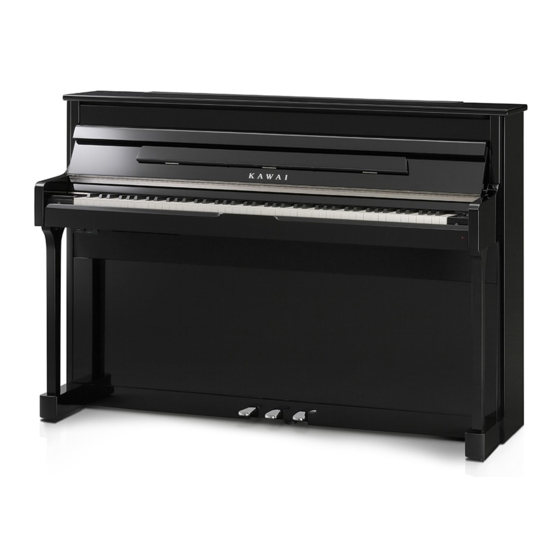
Advertisement
Quick Links
CS11/CS8 MIDI Settings Manual
MIDI Settings
MIDI Overview
The term MIDI is an acronym for Musical Instrument Digital Interface, an international standard for connecting
musical instruments, computers, and other devices to allow the exchange of performance data.
MIDI Terminals
MIDI terminal
MIDI IN
MIDI OUT
MIDI channels
MIDI uses channels to exchange data back and forth between MIDI devices. There are receive (MIDI IN) and transmit (MIDI OUT)
channels. Most musical instruments or devices with MIDI functions are equipped with both MIDI IN and OUT jacks and are capable of
transmitting and receiving data via MIDI. The receive channels are used to receive data from another MIDI device, and the transmit
channels are used to transmit data to another MIDI device.
The illustration below shows three musical instruments, connected together using MIDI.
Transmitting instrument a
Transmitting instrument a sends transmit channel and keyboard information to receiving instruments b/c.
The information arrives at the receiving instruments b/c.
Receiving instruments b/c will respond to MIDI data that is sent if their receive channel is the same as the transmit channel of the
transmitting instrument a. If the channels do not match, the receiving instruments b/c will not respond to any data that is sent.
For both receiving and transmitting, channels 1-16 can be used.
Recording/playing with a sequencer
When connected to a sequencer (or a computer running MIDI
sequencing software), the CS11/CS8 digital piano can be used
to record and playback multi-track songs, with separate sounds
playing simultaneously on each channel.
Function
Receiving note, program change, and other data.
Sending note, program change, and other data.
Receiving instrument b
1
Receiving instrument c
Sequencer
Advertisement

Summary of Contents for Kawai CS11
- Page 1 For both receiving and transmitting, channels 1-16 can be used. Recording/playing with a sequencer When connected to a sequencer (or a computer running MIDI sequencing software), the CS11/CS8 digital piano can be used to record and playback multi-track songs, with separate sounds playing simultaneously on each channel.
- Page 2 CS11/CS8 MIDI Settings Manual MIDI Settings MIDI Functions The CS11/CS8 digital piano supports the following MIDI functions: Transmit/receive note information Transmit/receive program change information Transmit/receive note information to/from a MIDI-connected Transmit/receive program change data to/from a MIDI- musical instrument or device.
-
Page 3: Midi Channel
Omni mode When the CS11/CS8 digital piano is turned on, the instrument is automatically set to ‘omni mode on’, allowing MIDI information to be received on all MIDI channels (1-16). When the MIDI Channel setting is used to specify a transmit/receive channel, the instrument will be set to ‘omni mode off’. - Page 4 CS11/CS8 MIDI Settings Manual MIDI Settings Send Program Change Number The Send Program Change Number function is used to send a Program Change Number (1-128) to the connected MIDI device. 1. Selecting the Send Program Change Number function After entering the MIDI Settings menu (page 2): Press the ...
-
Page 5: Local Control
The Local Control setting determines whether the instrument will play an internal sound when the keys are pressed. This setting may be useful when using the CS11/CS8 digital piano to control an external MIDI device that is connected to the instrument’s amplifier/speakers. - Page 6 SOUND buttons will send PGM# shown in the right column*. Program Change information will not be transmitted via MIDI. * Please refer to the ‘Program Change Number List’ on page 134 of “CS11/CS8 Owner’s Manual”. 1. Selecting the Transmit Program Change Numbers setting After entering the MIDI Settings menu (page 2): Press the ...
- Page 7 MIDI Settings Multi-timbral Mode The Multi-timbral Mode setting determines whether or not the CS11/CS8 digital piano is able to receive MIDI information on more than one MIDI channel simultaneously. This allows the instrument to play back multi-track, multi-timbral performance data sent from an external MIDI device.
-
Page 8: Channel Mute
* Any changes made to the Channel Mute setting will remain until the power is turned off. * Preferred Channel Mute settings can be stored to a Registration memory for convenient recall. Please refer to CS11/CS8 Owner’s Manual page 32 for more information. 3. Exiting the Channel Mute function... - Page 9 CS11/CS8 MIDI Settings Manual MIDI Exclusive Data Format 1st byte 2nd byte 3rd byte 4th byte 5th byte 6th byte 7th byte 8th byte 9th byte 10th byte Byte Description 1 F0 Start code 2 40 Kawai ID number 3 00 - 0F...
- Page 10 CS11/CS8 MIDI Settings Manual [DIGITAL PIANO] Date: November 2015 MIDI Implementation Chart Kawai CS11/CS8 Version: 1.0 Function Transmitted Section Remarks Default 1 - 16 1 - 16 Basic Channel Changed 1 - 16 1 - 16 Default Mode 3 Mode 1 * The default for the OMNI mode is ON.




